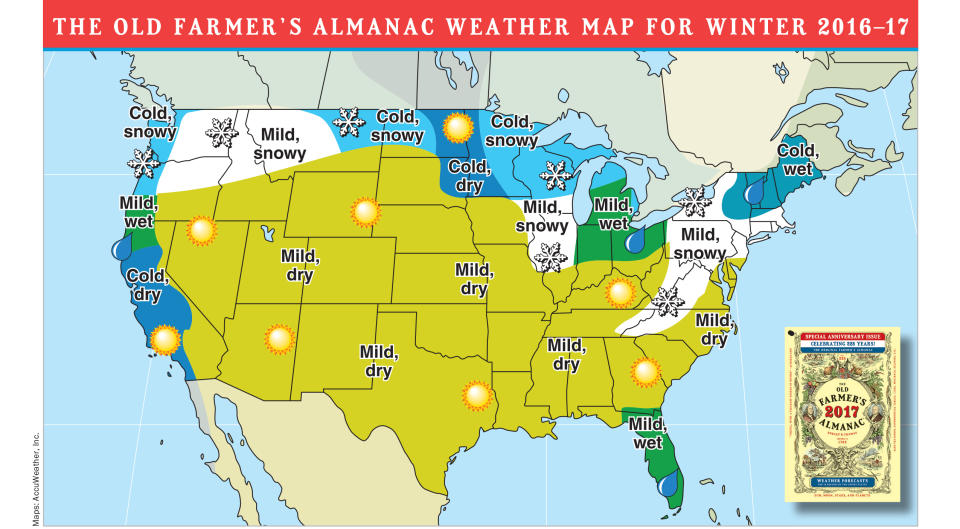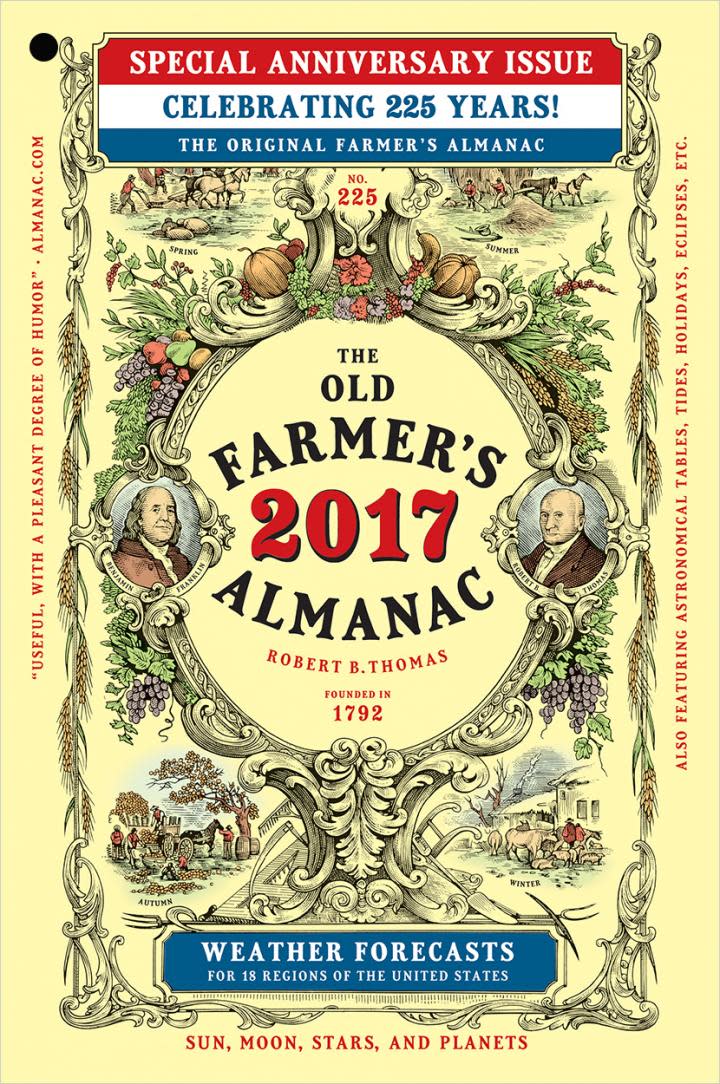Here's How Accurate the Farmer's Almanac Weather Predictions Really Are

This winter is going to be brutal. Freezing and snowy in the Northeast and Midwest, and warmer than average in the Pacific Northwest, where you'd actually want icy temps for skiing. We should all cancel our plans and head to the South, where they're getting a mild winter-right? Well, yes, if you believe the Old Farmer's Almanac, which released those predictions last month.
For the last 225 years, the Old Farmer's Almanac has put out long-term weather predictions, which they claim are about 80% accurate. But some meteorologists insist methods for forecasting the weather have changed since George Washington was in office and that the almanac's weather predictions are as old-fashioned as his powdered 'do.
We took a look back at the records, talked to meteorology experts and even the Old Farmer's Almanac's editor to figure out how, exactly, they're coming up with these predictions - and can we actually trust them?

Farmers' almanacs have been around for centuries, offering both weather forecasts and entertainment long before the internet, TV, and magazines were even around. The Old Farmer's Almanac and its rival, the Farmers' Almanac, which was introduced in 1818, still capture the public's attention each year when they release their much-anticipated long-term weather forecasts. They predict everything from temperatures to snowfall months in advance. Both maintain a level of secrecy around their approaches, which originated with their founders hundreds of years ago.
Here's what the Old Farmer's Almanac publishes in each issue to explain their methods:
We derive our weather forecasts from a secret formula that was devised by the founder of this Almanac, Robert B. Thomas, in 1792. Thomas believed that weather on Earth was influenced by sunspots, which are magnetic storms on the surface of the Sun.
The idea that variations in sunspots, which are dark regions on the sun's surface caused by cooler temperatures, can predict weather on Earth is a controversial one. But solar science is one of the main schools of thought that sets apart them apart from your local weatherman's forecast. As Old Farmer's Almanac editor Janice Stillman admits: "Some people don't believe that the minute amount of [energy] the sun bears could have any influence on the atmosphere and therefore the climate and the weather, but we are among those that do."

Today, the Old Farmer's Almanac explains in each issue they use - in addition to solar science and the study of sunspots - climatology, the study of weather patterns, and meteorology, the study of the atmosphere.
The exact formula, though, is famously covert - locked away for decades in an actual little black box. But Stillman says, rest assured, their meteorological technology and methods are absolutely up to date.
"If I were to tell you we used the same methods we used in 1792, you might think we used the same equipment and certainly that's not true. But the principals upon which the forecasts are made are essentially the same," Stillman says. "Of course, we use the latest state-of-the-art satellite data, all the latest technology."
In other words, their equipment is up to date, but their methods are a mix of old (sun spots) and new (meteorology). But some meteorologists say the out-of-this-world sunspot piece of the mysterious puzzle is problematic.
"The farmers' almanacs use things like sunspots, while, for modern meteorology, we use weather forecast models that solve equations that try to describe how our atmosphere actually works," says J. Marshall Shepherd, the former American Meteorology Society president and University of Georgia professor of atmospheric sciences.
Stunned some media sources won't cover hard, peer-reviewed weather/climate science, yet will cover forecasts from almanac or a groundhog
- Marshall Shepherd (@DrShepherd2013) August 16, 2015
Critics also question the Old Farmer's Almanac's claim of 80% accuracy.
"They say from November 5 through 10, for that whole period: sunny/cool. If one day is sunny and cool, does that count? Does every day have to be sunny and cool? If you held them to every single word for the entire area and every word for the entire period, then I say they might not even be right one third of the time. In fact, they might be right 10 percent of the time," Penn State meteorologist Paul Knight said in 2007. "I don't think they're holding themselves to that degree of accuracy, and I don't think other people are either."
Each year, the Old Farmer's Almanac publishes an analysis of their forecast from the previous year, and they give themselves a percentage score. For example, last year, they say they were 55.6% accurate (they write they misjudged El Nino's strength, which threw off the forecast), while in 2014-15 they gave themselves a 96.3%. Stillman maintains that the Old Farmer's Almanac still has about an 80% accuracy track record, but admits that those numbers are determined by looking at monthly averages - as opposed to judging each day's forecast - which some say is a generous yardstick.
Your annual reminder that using the Farmers Almanac for a seasonal meteorological is about as good as going to a psychic.
- Matt Lanza (@mattlanza) August 16, 2015
"If the almanac has issued a good forecast it's hard to say whether the process made it good or if it was chance, because the details of how they came up with it are a secret. To be able to determine that, you'd need to know how they issued their forecast," says Bob Henson, weather and climate blogger at Weather Underground, which does short-term weather forecasts. "Accurate versus skillful is another thing. It's easy to be accurate with forecasts in a place like Phoenix [where it's often hot]. It's much more difficult to give a skillful forecast in a lot of places."
So, back to the question at hand: Can you trust a long-term almanac weather forecast? If you're asking most meteorologists, the answer is no, you can't trust weather predictions beyond 10 days.
But in spite of skepticism from meteorologists, the public still eagerly anticipates the release of the almanacs' long-term weather forecasts. Stillman says they print and deliver 3 million copies of the Old Farmer's Almanac to the U.S. and Canada each year. Farmers themselves are less enthusiastic, though. According to a 2013 paper published in scholarly journal Weather, Climate, and Society, just 18% of farmers use a farmer's almanac when planning their crops.

But if you're determined to ignore your weatherman's 10-day rule and to plan your year around an almanac, at least take Stillman's advice.
"Weddings are one of the most popular subjects we get asked about. We'll give them the forecast, we'll remind them that they're traditionally 80% accurate," she says. "And I always suggest they rent a tent. You're still outside, so you want to be protected."
You Might Also Like

